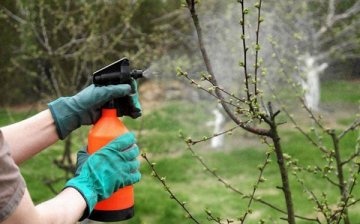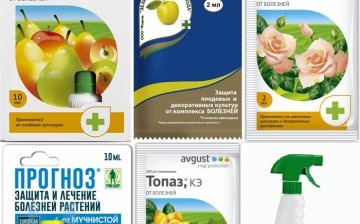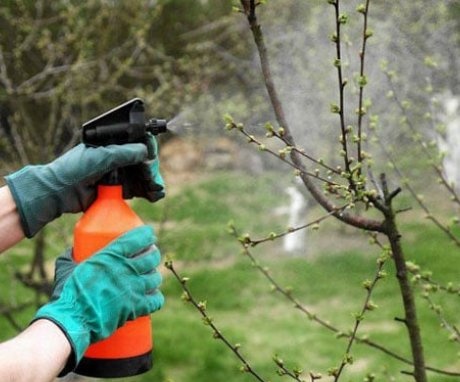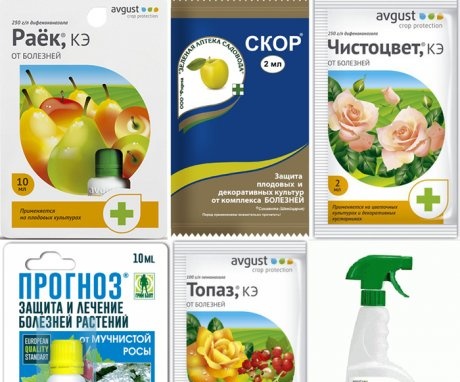Fungicidal action - what is it in gardening?
Any gardener knows that plants can get sick. The harvest suffers from this. The most common and dangerous are fungal diseases. They attack the plant very quickly, leaving microspores. Substances called fungicides... These are chemicals designed specifically to fight disease-causing fungi. The use of fungicides in horticulture has its pros and cons.
Content:
- Mechanism of action of fungicides
- Classification of modern fungicides
- Advantages and disadvantages
- Review of the best fungicides
- How to use fungicides and how to replace them?
Mechanism of action of fungicides
Any chemical that is designed to combat plant diseases, pests, and weeds is called a pesticide. One of the types of pesticides are fungicides, which have a narrow focus, they help get rid of the fungus. The effect of the drug depends on its type. Some fungicides are aimed at prevention, others at treatment and destruction of an existing fungus.
Fungicidal action is the effect of the drug on the spores of the fungus, which inhibits its reproduction and destroys the cells.
Treating an existing fungus is difficult, as it spreads quickly and infects healthy plants, so most gardeners prefer to use fungicides for prophylaxis in order to prevent the occurrence of diseases. You can use fungicides before or after any signs of fungal disease appear. These signs include black or white spots on the leaves and stems, fruit damage, signs of decay, leaf fall.
The mechanism of action of fungicides is diverse. It often includes:
- Plant immunization. Substances penetrate into plant cells and provoke the production of their own protective substances that help fight the fungus.
- Formation of necrosis. At first glance, such an action may seem harmful. But areas of necrosis on a plant are protection. They prevent the fungus from penetrating deeper into plant tissues.
- Suppression of energy metabolism. The drugs disrupt the process of energy metabolism in the cells of the fungus, preventing it from developing and multiplying.
- Hyperparasitism. Some substances fight fungi in the following way: they penetrate the structure of the plant, release toxic substances that suppress the development of the fungus, and then feed on the products of their decomposition. In other words, the drug is parasitic on the fungus.
Preparations can be complex, that is, combine different effects on the plant and the fungus. However, most fungicides act selectively, that is, they are aimed at certain types of fungus.
Classification of modern fungicides
Fungicides are divided into groups. There are many classifications. The choice of this or that drug depends on the type of plant and the fungus itself, the purpose and characteristics of the drug's use. There is no universal fungicide. For each case, you need to select your own option.
Each type of fungicide has its own advantages and disadvantages.It must be remembered that the same drug may act differently in different cultures. Also, the effect differs with the use of different doses and timing.
There are several classifications of the fungicide:
- By chemical properties. Fungicides are organic and inorganic. In organic there are no heavy metals, they decompose naturally under the action of bacteria. Inorganic fungicides are more persistent and in some cases more effective, but they require more careful use and accurate dosage.
- By action on the causative agent of the disease. This classification includes both prophylactic and curative fungicides. The first ones prevent the appearance of infection, increase the immunity of plants, their defenses. The latter are aimed at destroying the already existing fungus.
- By the purpose of the application. The purpose of the fungicide can be different. Some preparations are intended for dressing seeds, others - for processing the soil, ground parts of plants, fruits during storage. There are versatile fungicides that can be applied to the soil and sprayed on top of the plant at the same time.
- By the nature of distribution in plant tissues. Many gardeners strive to purchase those drugs that do not penetrate into the plant, that is, they are contact. They are found only on the surface of the plant, causing the death of the fungus. However, the effectiveness of such fungicides depends on many factors: dosage, uniformity of distribution, precipitation and weather conditions. Systemic fungicides penetrate plant tissues, therefore they act faster and do not react to weather conditions.
Before using the fungicide, you must carefully read the instructions. The preparation should indicate for which plant and to combat which fungi it is intended.
Advantages and disadvantages
Gardeners have different attitudes towards the use of fungicides. Some try to avoid them, as they believe that they are harmful to the plants and fruits themselves, while others use them constantly for preventive purposes in order to protect their crops.
It can be said unambiguously that fungicides have a definite effect on the plant. They try to minimize the harm from the use of drugs, but it is difficult to completely eliminate it. However, the harm from fungicides is not comparable to the harmful effects of fungi, which can completely destroy the crop and remain in the soil.
The advantages of fungicides are:
- High efficiency. Fungicides usually have a wide spectrum of action, that is, they destroy a large number of fungal strains. There are more targeted drugs against a specific fungus, their effectiveness is also high, if the drug is chosen correctly.
- Availability. Fungicides can be found at any gardening store. Their prices are different, but you can easily find a drug that you can afford.
- Fast effect. Inorganic fungicides act as quickly as possible, organic a little slower. But in any case, you won't have to wait long for the effect. This is very important for fungal diseases that spread quickly and infect healthy plants.
- The ability to use in large areas. Fungicides can be dissolved in water and treated over a large area. They allow you to process the largest possible number of crops in the shortest possible time.
The question of the harm of fungicides is raised quite often. Of course, any drugs, acting on the causative agent of the disease, affect the body itself. Fungicides cannot be called absolutely harmless, but the question of the balance of benefits and risks is raised here.
The disadvantages sometimes include the fact that after processing for some time it is impossible to eat fruits if the procedure was carried out during fruiting. Therefore, it is recommended not to neglect prevention. In this case, smaller doses of the drug will be needed, and the harm to the plant itself and the environment will be minimal.
Review of the best fungicides
You can easily buy fungicides on the market or in a specialized store, order on the Internet. However, effectiveness can only be expected if the drug is not counterfeit. Therefore, it is better to buy it from trusted manufacturers.
The choice of drugs is quite large, it can be difficult to choose. You can find customer reviews on the Internet. However, it is worth considering the specifics of a particular drug. What suits one gardener may disappoint another.
Among the most popular fungicides are:
- Alirin B. This is a natural biofungicide, which contains beneficial soil microflora, which allows suppressing the growth of fungi. The drug can be used against powdery mildew, white rot, late blight, rust and other fungi. The peculiarity of this fungicide is that it can not only be used for soil and ground parts of plants, but also reduces the level of soil toxicity after applying other chemicals.
- Bordeaux mixture... One of the most powerful drugs for combating fungal diseases of plants. It contains copper sulfate. The product can be used for almost any garden plant. However, this mixture is dangerous for humans. It must be used with care, observing safety rules and using protective clothing. Copper sulfate in the composition quickly and effectively destroys any fungus.
- Oxyhom. This fungicide is considered a contact-systemic one. It can be used for both prevention and treatment of fungal diseases. Oxychom is effective against powdery mildew, macrosporiosis, late blight and other fungal diseases. The preparation contains copper oxychloride and oxadixil.
- Topaz... This systemic fungicide has been around for a long time. It is commonly used to treat powdery mildew and rust. This drug is effective and not highly toxic. It takes effect within a few hours after use.
Some gardeners use folk remedies in parallel to increase the effectiveness of drugs. However, in most cases, the fungicide is sufficient.
How to use fungicides and how to replace them?
Fungicides can be applied in several ways: by applying to the soil, spraying plants, or dressing seeds. In order for the effectiveness to be high, the terms and rules for the use of fungicides must be observed:
- Use fungicides only as needed. Even if the infection did not occur and fungicides are needed only for prophylaxis, there are certain periods when the infection can occur. Uncontrolled use of fungicides can harm the crop.
- Contact fungicides only protect the parts of the plant to which they are exposed. Therefore, it is necessary to spray the plants thoroughly and from all sides, so as not to miss anything. It is advisable to do this in calm weather, so that part of the drug is not scattered by the wind. Rain will significantly reduce the effectiveness of the drugs.
- Systemic fungicides are effective immediately regardless of rainfall. However, fungi quickly develop immunity to them, so it is advisable to use these drugs no more than 2 times a year.
Some gardeners categorically do not want to use chemicals to protect against fungi, so they are looking for something to replace fungicides with. Unfortunately, fungal diseases of plants are quite common, and it is quite rare to refuse to use fungicides. You can use folk recipes. So, for example, to fight the fungus, an infusion of garlic is recommended, potassium permanganate or sulfur solution. However, it must be remembered that the effectiveness of these funds is not always high.
If the plants are already infected with the fungus, experimentation can lead to loss of time and yield.
For gardeners who do not want to use toxic fungicides, organic varieties can be recommended.Organic fungicides include Bactofit, Fitosporin, etc. They contain live microorganisms, therefore they are safe for people, animals and even insects.
More information can be found in the video:



















